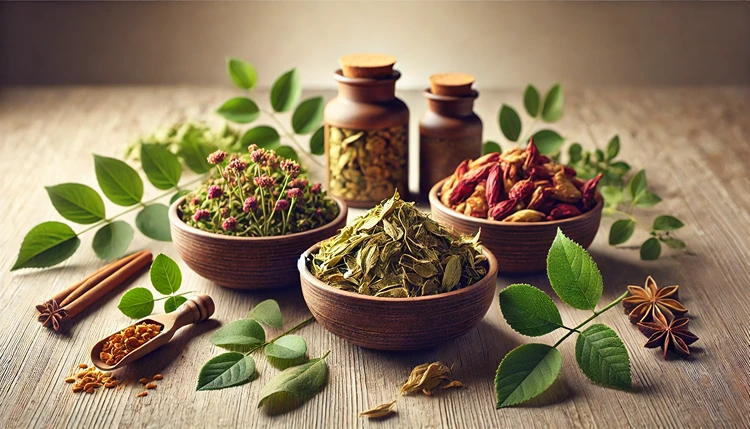
Lesser-Known Ayurvedic Herbs for Hormonal Balance and Wellness
When it comes to hormonal balance, many people turn to Ayurveda, an ancient Indian system of medicine. It offers a natural approach using herbs that are known for balancing hormones, supporting wellness, and restoring equilibrium in the body. While popular herbs like Ashwagandha and Shatavari often take the spotlight, there are many lesser-known Ayurvedic herbs that can be incredibly effective in promoting hormonal balance. These hidden gems may not be as widely discussed, but they deserve more recognition for their benefits in overall wellness. Let’s explore some of these herbs, their effects on hormones, and how they contribute to better health.
What Are Hormonal Imbalances?
Hormonal imbalances occur when there’s too much or too little of a particular hormone in the bloodstream. Hormones play a critical role in regulating several bodily functions, including metabolism, mood, reproductive health, and energy levels. When hormones are out of balance, it can lead to conditions like polycystic ovary syndrome (PCOS), thyroid disorders, or adrenal fatigue. Many women experience issues related to hormonal fluctuations, especially during periods like menopause, pregnancy, or menstruation. Fortunately, Ayurvedic herbs can offer relief by gently helping to restore balance without the need for synthetic interventions.

How Ayurveda Approaches Hormonal Balance
In Ayurveda, balance is the key to good health. According to this system, an imbalance in the body’s energy forces, or “doshas,” often leads to issues like hormonal imbalances. Ayurveda uses a combination of dietary changes, lifestyle practices, and herbal treatments to bring the body back into balance. This holistic approach can help regulate hormones and promote overall wellness. The lesser-known herbs that Ayurveda offers for hormonal health target specific imbalances by nourishing the body, reducing stress, and calming the nervous system.
Which Ayurvedic Herbs Help with Hormonal Balance?
Here’s a look at some lesser-known Ayurvedic herbs that play a key role in balancing hormones:
1. Lodhra for Menstrual Health
Lodhra (Symplocos racemosa) is often used in Ayurvedic medicine to support women’s reproductive health. It helps regulate menstrual cycles, reduce excessive bleeding, and soothe PMS symptoms. Lodhra also supports hormonal balance by nourishing the reproductive system and promoting a healthy uterine environment. For women dealing with hormonal imbalances like PCOS, Lodhra may help in regulating periods and reducing symptoms like acne or weight gain.
Helpful Hint:
If you’re experiencing irregular menstrual cycles, combining Lodhra with a balanced diet and stress management techniques can further enhance its effects.
2. Shankhpushpi for Stress-Induced Imbalances
Shankhpushpi (Convolvulus pluricaulis) is known for its ability to reduce stress and calm the nervous system. Stress is one of the leading causes of hormonal imbalances, as it disrupts the production of key hormones like cortisol and insulin. Shankhpushpi’s adaptogenic properties make it a great herb for balancing cortisol levels, which helps the body adapt to stress more effectively. Lower stress levels often lead to better hormone regulation, improving mood, sleep, and overall well-being.
Stats:
Research indicates that chronic stress can increase cortisol production by up to 50%, leading to hormonal disruptions. Reducing stress through herbs like Shankhpushpi can significantly lower cortisol levels and improve hormonal health.
3. Guduchi for Balancing Female Hormones
Guduchi (Tinospora cordifolia) is another lesser-known herb that plays a role in balancing female hormones. Often used in the treatment of PCOS and menopause symptoms, Guduchi helps regulate the menstrual cycle and reduce inflammation, which is a common issue in hormone-related disorders. Its anti-inflammatory properties also make it beneficial for reducing the discomfort associated with menstrual cramps and bloating.
4. Musta for Menopause and Hormonal Shifts
Musta (Cyperus rotundus) is a cooling herb that is especially beneficial for women going through menopause. It helps manage hot flashes, mood swings, and night sweats by regulating the production of estrogen. Musta is also helpful in reducing inflammation and supporting digestion, which is often affected by hormonal changes.
5. Kapikacchu for Boosting Libido and Fertility
Kapikacchu (Mucuna pruriens), also known as velvet bean, is a powerful Ayurvedic herb that is used to increase libido and support fertility in both men and women. It enhances the production of dopamine, a neurotransmitter that plays a role in mood, energy, and sexual desire. By supporting a healthy libido and improving reproductive health, Kapikacchu can be a valuable addition to anyone looking to balance their hormones.
6. Bala for Rejuvenating Female Reproductive Health
Bala (Sida cordifolia) is a lesser-known Ayurvedic herb traditionally used to support the female reproductive system. Its rejuvenating properties help strengthen the body, improve stamina, and restore balance to reproductive hormones. Bala also aids in reducing inflammation, which is crucial for those experiencing hormonal imbalances linked to menstrual pain, PCOS, or other reproductive conditions. Bala works by nourishing tissues and providing energy to the body, making it an ideal herb for those feeling fatigued or overwhelmed by hormonal fluctuations.
7. Manjistha for Detoxification and Hormonal Balance

Manjistha (Rubia cordifolia) is a powerful blood-purifying herb used in Ayurveda to support the body’s detoxification process. Hormonal imbalances are often exacerbated by the buildup of toxins in the body, particularly in the liver, which is responsible for processing hormones. Manjistha supports liver function and helps the body eliminate toxins, which in turn supports the regulation of estrogen and other hormones. It is particularly helpful for clearing skin conditions like acne, which can be caused by hormonal disruptions.
8. Yashtimadhu for Supporting Adrenal Health
Yashtimadhu (Glycyrrhiza glabra), also known as licorice root, is an Ayurvedic herb well-known for its ability to support adrenal health. The adrenal glands are responsible for producing cortisol, the stress hormone. Prolonged stress can lead to adrenal fatigue, disrupting hormone production and leading to issues like irregular menstrual cycles or thyroid imbalances. Yashtimadhu helps regulate cortisol levels and provides relief from stress-related hormonal imbalances. Its anti-inflammatory properties further contribute to its effectiveness in supporting overall hormonal health.
Helpful Hint:
To make the most of Yashtimadhu, consider using it as a tea or powder. Always consult an Ayurvedic practitioner for guidance on the appropriate dosage.
9. Shatavari for Menstrual and Reproductive Health
While Shatavari (Asparagus racemosus) is relatively better known in Ayurveda, it’s important to highlight its specific benefits for hormonal balance, especially for women. Shatavari is often referred to as the “queen of herbs” in Ayurveda due to its ability to regulate estrogen levels, support fertility, and reduce symptoms of PMS and menopause. This herb also enhances the body’s natural defenses, helping the body manage stress, which can play a significant role in balancing hormones. For those experiencing hormonal fluctuations due to life stages such as menopause or post-pregnancy, Shatavari provides a safe and natural option.
Herbal Combinations for Enhanced Hormonal Support
Many Ayurvedic practitioners recommend combining different herbs for optimal hormonal balance. This is based on the principle that herbs work synergistically, meaning their combined effects can be greater than their individual benefits. For example, combining Shatavari with Lodhra can provide comprehensive support for menstrual health, while using Guduchi alongside Manjistha may enhance detoxification and hormonal regulation. Working with an Ayurvedic expert to find the right combination for your specific needs is a great way to maximize the benefits of these herbs.
10. Jatamansi for Balancing Mood and Hormones
Jatamansi (Nardostachys jatamansi) is a lesser-known Ayurvedic herb valued for its ability to calm the nervous system and balance hormones that regulate mood, such as serotonin and dopamine. Hormonal imbalances often lead to mood swings, anxiety, or depression. Jatamansi’s calming properties help stabilize the mind and body, reducing emotional distress caused by hormonal changes. By supporting both mental and hormonal health, this herb is an excellent option for those struggling with stress-induced imbalances.
Ayurvedic Herbs for Hormonal Balance and Their Benefits
| Herb | Key Benefit | Common Use | How It Helps |
|---|---|---|---|
| Lodhra | Menstrual Health | Regulating cycles | Helps balance estrogen and reduce excessive bleeding |
| Shankhpushpi | Stress Reduction | Reducing cortisol | Supports the nervous system and calms stress-induced hormone disruption |
| Guduchi | Inflammation Reduction | PCOS, Menopause | Balances female hormones and reduces inflammation |
| Musta | Menopausal Support | Menopause symptoms | Reduces hot flashes and mood swings |
| Kapikacchu | Libido & Fertility | Sexual wellness | Boosts dopamine production and supports reproductive health |
| Yashtimadhu | Adrenal Support | Stress management | Regulates cortisol and reduces adrenal fatigue |
Tips for Using Ayurvedic Herbs Safely
While Ayurvedic herbs are natural, they are still powerful and should be used mindfully. Here are a few tips to ensure you get the best results from your herbal treatments:
- Consult with an Ayurvedic practitioner before starting any new herbal regimen, especially if you’re pregnant, nursing, or taking medications.
- Start with a small dose and gradually increase it to avoid any adverse reactions.
- Be consistent with your herbal treatments, as it can take time for the body to respond to natural remedies.
FAQs
Final Words
Ayurvedic herbs offer a natural, holistic approach to managing hormonal balance and overall wellness. While lesser-known, herbs like Lodhra, Shankhpushpi, and Bala bring profound benefits, particularly for women facing hormonal imbalances. Their ability to regulate stress, support menstrual health, and improve reproductive wellness makes them powerful allies in promoting natural hormonal harmony. By incorporating these herbs into your daily routine, you can nurture your body in a balanced, sustainable way. Always remember to seek personalized advice to ensure these natural remedies work best for your unique needs.














